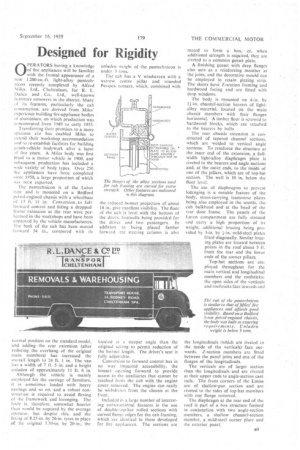Designed for Rigidity
Page 43

If you've noticed an error in this article please click here to report it so we can fix it.
0 PERATORS having a knowledge of fire appliances will be familiar with the frontal appearance of a new 1,200-cu.-ft. light-alloy pantechnicon recently completed by Alfred Miles, Ltd., Cheltenham, for R. L. Dance and , Co., Ltd., well-known furniture removers in thc district. Many of its features, particularly the cab construction, are derived from Miles' experience building tire-appliance bodies of aluminium, on which production was concentrated from 1949 to early 1955.
Transferring their premises to a more spacious she has enabled Miles to extend their workshop accommodation and to re-establish facilities for building goods-vehicle bodywork after a lapse of five years. A Miles body was first fined to a motor vehicle in 1900, and subsequent production has included a wide variety of body types. Over 250 lire appliances have been completed since 1950, a large proportion of which HIS been exported.
The pantechnicon is of the Luton type and is mounted on a Bedford petrol-engined chassis with a wheelbase of 13 ft. II in. Conversion_to fullforward control and fitting a droppedframe extension at the rear were performed in the workshops and have been approved by the vehicle manufacturers. The back of the cab has been moved forward 34 in compared with its normal position on the standard model, and adding the rear extension (after reducing the overhang of the .original main members) has increased the overall length to 24 ft. 1 in. The van has a width of 7 ft. 5 in. and a height unladen of approximately 11 ft. 6 in.
Although the vehicle is mainly employed for the carriage of furniture, it is sometimes loaded with heavy castings and so on, and a robust construction is required to avoid flexing of the framework and lozenging. The body is. therefore, somewhat heavier than would be required by the average operator, but despite this, and the fitting of 8.25-in. by 20-in. tyres in place of the original 7.50-in. by 20-in., the
unladen weight of the pantechnicon is under 3 tons.
The cab has a V windscreen with a narrow centre pillar and rounded Perspex corners, which, combined with the reduced bonnet projection of about 18 in_ give excellent visibility. The floor of the cab is level with the bottom of the doors, footwells being provided for the driver and two passengers. In addition to being placed farther forward. the steering column is also located at a steeper angle than the original setting to permit reduction of the bonnet length. The driver's seat is fully adjustable.
Conversion to forward control has in no way impaired accessibility, the bonnet opening forward to provide access to the auxiliaries that cannot be reached from the cab with the engine cover removed. The engine Can easily be withdrawn from the chassis at the front.
Included in a large number of interesting constructional features is the use of double-top-hat rolled sections with curved flanee edges for the cab framing, which are identical to those developed for fire appliances. The sections are mated to form a box, or, when additional strength is required, they are riveted to a common gusset plate.
A finishing gusset with deep flanges also acts as a reinforcing member at the joins, and the decorative mould can be employed to retain glazing strip. The doors have Z-section framing and hardwood facing and are fitted with drop windows.
The body is mounted on 4-in. by N-in. channel-section bearers of lightalloy material, located on the main chassis members with their flanges horizontal. A timber floor is screwed to hardwood blocks, which are attached to the bearers by bolts.
The rear chassis extension is constructed of tapered channel seetions, which are welded to vertical angle sections. To reinforce the structure at the inner end of the extension, a fullwidth light-alloy diaphragm plate is riveted to the bearers and angle sections and, at the outer ends, to the inside of One of the pillars, which are of top-hat section. The well is 10 in. below the floor level.
The use of diaphragms to prevent lozenging is a notable feature of the body, stress-carrying transverse plates being also employed in the scuttle, the cab bulkhead and at the head of the rear door frame. The panels of the Luton compartment are fully stressed and carry a high proportion of its weight, additional bracing being pro vided by 3-in, by mild-steel plates fitted diagonally. Similar bracing plates are located between points in the roof about 5 ft. from the rear and the lower ends of the corner pillars.
Top-hat sections are employed throughout for the main vertical and longitudinal members and the roofsticks; the open sides of the verticals and roofsticks face inwards and the longitudinals (which are riveted to the inside of the verticals) face outwards, Z-section members are fitted between the panel joins and one of the flanges of the longitudinals.
The verticals are of larger section than the longitudinals -and are riveted at their upper ends to angle-section cant rails. The front corners of the Luton are of shallow-pan section and are riveted to the sides of top-hat members with one flange removed.
The diaphragm at the rear end of the roof is part of a box structure formed in conjunction with two angle-section members, a shallow channel-section member, a mild-steel corner plate and the exterior panel.




































































































